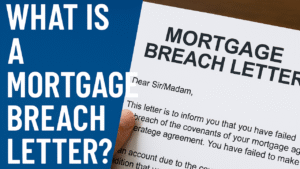 What Is a Mortgage Breach Letter in a Home Foreclosure Process?
What Is a Mortgage Breach Letter in a Home Foreclosure Process?
When homeowners fall behind on their mortgage payments, the road to foreclosure doesn’t begin overnight. One of the first formal steps lenders must take in many cases is sending a Mortgage Breach Letter. This document is both a warning and a requirement, giving homeowners an opportunity to cure the default before the foreclosure process begins. Understanding what a breach letter is—and what to do when you receive one—can be the difference between saving your home and losing it.
What Is a Mortgage Breach Letter?
A Mortgage Breach Letter (sometimes called a default letter) is a formal notice from your lender that you’re in violation of your mortgage contract, usually because of missed payments. This letter is a requirement in most mortgages backed by Fannie Mae, Freddie Mac, or private lenders following standard lending practices.
In essence, the breach letter gives the borrower:
- Notice of the default
- Explanation of how to fix the issue
- A time frame (often 30 days) to bring the loan current
- A warning that failure to cure the default will result in foreclosure
It’s often the last chance for homeowners to stop the foreclosure process before the lender takes legal action.
Why Is the Letter Important?
The breach letter plays a critical role in protecting homeowners from sudden foreclosure. Without this step, a borrower might not even realize their loan is in serious jeopardy. It also fulfills a legal requirement in many states and under most mortgage contracts. In fact, if a lender skips this step and initiates foreclosure proceedings, the borrower may have legal grounds to challenge the foreclosure in court.
In many mortgage contracts, especially those using the Fannie Mae/Freddie Mac Uniform Instrument, the breach letter is required under Paragraph 22. This clause lays out the terms under which a lender can accelerate the loan (demand full repayment immediately) and begin foreclosure. Skipping the breach letter violates this clause and may invalidate the foreclosure process.
What Does a Breach Letter Include?
A properly drafted mortgage breach letter typically includes:
- The nature of the default (e.g., missed payments)
- The total amount required to cure the default
- Instructions on how to bring the loan current
- A deadline—usually 30 days from the date of the letter
- A statement that failure to cure will result in acceleration of the loan and potential foreclosure
- Contact information for the lender or servicer
If you receive a breach letter, read it carefully. Make sure the amount listed matches your records and note the date by which you must act.
What Should You Do If You Receive a Breach Letter?
Receiving a breach letter can be alarming, but it also gives you time and options. Here are some recommended steps:
- Don’t Ignore It
A breach letter is your official warning. Ignoring it could result in losing your home. - Verify the Claims
Ensure the amount they say you owe is accurate. Mistakes do happen, and mortgage servicers are not immune to error. - Contact Your Lender or Loan Servicer
If you’re unable to pay the full amount by the deadline, ask about options. You may qualify for:- A loan modification
- Forbearance
- A repayment plan
- Refinancing
- Speak With a Housing Counselor or Attorney
The U.S. Department of Housing and Urban Development (HUD) offers free or low-cost housing counseling. An attorney experienced in foreclosure law can also help you navigate the process. - Document Everything
Keep records of every communication with your lender, including phone calls, emails, and mailed correspondence. This could be crucial if you need to contest the foreclosure later.
What Happens After the Breach Letter?
If you do not cure the default within the time frame provided in the breach letter, the lender has the right to:
- Accelerate the loan (demand the entire balance immediately)
- File a foreclosure lawsuit (in judicial foreclosure states)
- Initiate a foreclosure sale (in nonjudicial foreclosure states)
Once that process begins, it becomes more difficult—and more expensive—to stop. That’s why responding to the breach letter quickly is vital.
Final Thoughts
The mortgage breach letter is a pivotal moment in the foreclosure process. While it signals serious financial trouble, it also offers a final opportunity to resolve the issue before facing the loss of your home. Whether through payment, negotiation, or legal assistance, homeowners should take the letter seriously and act quickly. Understanding your rights and options could mean the difference between staying in your home or being forced out.
If you’ve received a breach letter, don’t panic—but don’t wait either. There is still time to turn things around.